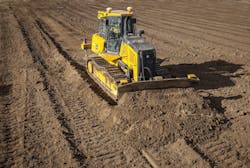Trimble Earthworks Grade Control
Trimble Earthworks for Excavators and Earthworks for Dozers offer integrated 3D aftermarket automatics capability for excavators, and a new dozer configuration moves the receivers from the blade to the roof of the cab.
Reengineered from the ground up, the grade control platform features intuitive, easy-to-learn software that runs on an Android operating system.
The Trimble Earthworks grade control application is built on the Android operating system, and runs on the new 10-inch Trimble TD520 touch-screen display. The Earthworks application was developed based on feedback from construction equipment operators around the world, resulting in an interface optimized for productivity, Trimble says. Colorful graphics, natural interactions and gestures, and self-discovery features make the software intuitive and easy to learn. Each operator can personalize the interface to match their workflow and a variety of configurable views make it easier to see the right perspective for maximum productivity.
In addition, Earthworks allows data files to be transferred to or from the office wirelessly and automatically so that the operator is always using the latest design. Using the Android operating system, users can download other applications that provide the operator with additional useful tools inside the cab. To make the system even more flexible, contractors can use the Trimble TD520 display or a third-party Android device.
Excavator Automatics
Operators can create smooth, flat, or sloped surfaces more easily. When the excavator is placed in Autos mode, the operator controls the stick, and Trimble Earthworks controls the boom and bucket to stay on grade, reduce overcut, and increase production. By automating excavator operation, Trimble Earthworks allows operators to achieve grade consistently, with high accuracy and in less time.
Mastless Dozer Configuration
Trimble Earthworks for Dozers mounts dual GNSS receivers on top of the cab to eliminate masts and cables traditionally located on the blade. The dual GNSS receivers are ideal for steep slope work and complex designs with tight tolerances. The new configuration keeps valuable receivers safer and can also save contractors time by reducing the time needed to remove and reinstall them each day.
